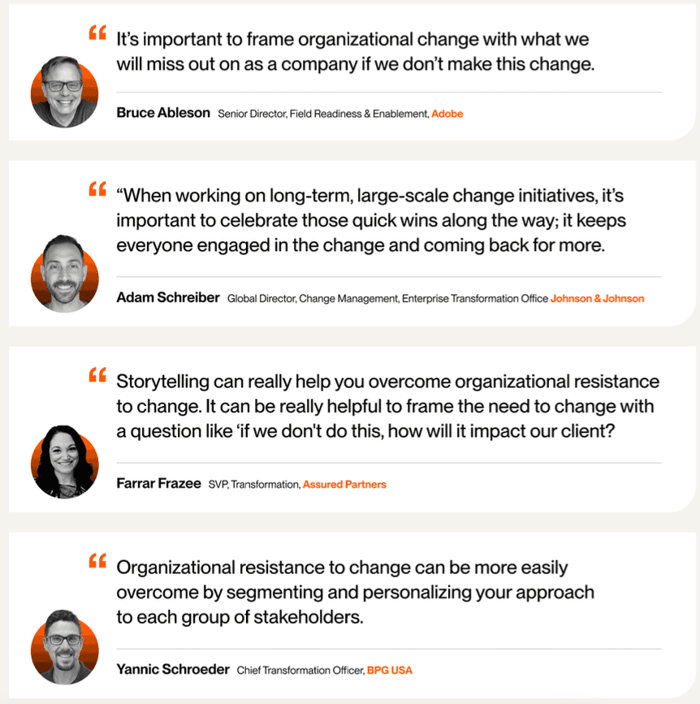The Executive Council for Leading Change (ECLC) convened for a roundtable discussion focusing on addressing internal resistance to change in workplace settings. The executives shared insights, challenges, and strategies related to leading organizational change despite various forms of resistance. The conversation delved into various aspects of change, including stakeholder engagement, leadership buy-in, communication strategies, talent retention, and the role of metrics in measuring change progress.

4 Key Strategies for Addressing Internal Resistance to Change
Transparent Communication: Fostering transparency in communications helps to alleviate fear and uncertainty among employees. Adam pointed out that, even if the message needs to change over time, it’s better to maintain communication throughout the organization than to leave employees in the dark, as consistent updates enable them to adapt and align their efforts more effectively.
1. Early Stakeholder Engagement
Proactively involving stakeholders from the outset helps in gaining buy-in and mitigating resistance early on. It helps to foster an environment that feels more collaborative and, ultimately, more conducive to overall organizational change.
2. Storytelling
Storytelling helps to convey the impact of change initiatives and rally employees around such initiatives. Farrar pointed out that storytelling that is rooted in the culture of your company can help everyone adapt to change, as it cements what is new into the DNA of your organization.
3. Leadership Buy-In
Securing commitment and sponsorship from senior leadership is crucial for driving change effectively. Yannic expressed that, without buy-in from other senior executives, it’s hard to justify the costs and effort that will go into a large-scale transformation initiative as well as its longevity.
4. Performance Metrics
Implementing performance metrics and adoption dashboards helps to track progress and measure the impact of change initiatives over time. By using a platform like Tigerhall, abstract concepts like employee sentiment and the adoption of change become measurable data points. This data can then be transmitted to important stakeholders, to keep them engaged through long-term, large-scale initiatives.
Voices of the ECLC

4 Successful Approaches and Tactics
1. Proactive Talent Retention
Developing proactive talent retention strategies helps to retain critical roles and high-performing talent during times of change. Ani pointed out that talent retention should be proactive instead of reactive, so that your top performers feel like they are a part of the change. This reduces friction while avoiding costly turnover, ultimately ensuring stability and continuity within the organization's workforce.
2. Leadership Coaching
Providing coaching and support for leaders helps them effectively drive change within their teams. Bruce explained that there is a difference between senior executives understanding a change initiative and knowing how to promote it amongst their departments. They might be sold on the need to change but they in turn need to sell the change to others.
3. Honest Communication
Practicing honesty and transparency in communication helps to address both ongoing successes and challenges openly. Yannic expressed that, even if the direction changes slightly over time, more people are on board with change initiatives if they feel like they are given the opportunity to understand what is going on and the opportunity to ask questions.
4. Individual Goal Alignment
Aligning individual goals with change objectives makes the change more tangible and relevant to employees. Bruce presented that incorporating change initiatives within a department’s or employee’s KPIs or quarterly goals makes it easier for the change to be incorporated into everyday work.
2 Common Challenges Faced
1. Ambivalence of Leadership
Dealing with leadership ambivalence or apathy towards change initiatives is crucial as it hinders the progress and support of these initiatives. Leadership ambivalence can occur when there are too many changes happening at once. That’s where prioritizing and refocusing on key initiatives might be necessary.
2. Neutral Stakeholder Engagement
Engaging neutral stakeholders directly might be necessary as silence does not always translate to acquiescence. They might remain passive or skeptical towards the change which will in turn slow it down.
Conclusion
In summary, the ECLC roundtable highlighted the importance of proactive stakeholder engagement, transparent communication, leadership commitment, storytelling, and performance metrics in navigating organizational change. Where challenges such as leadership ambivalence and neutral stakeholder engagement persist, tackling these issues head on can help organizations drive change effectively and achieve desired outcomes.
The Executive Council for Leading Change
The Executive Council for Leading Change (ECLC) is a global organization that brings executives together to redefine the landscape of organizational change and transformation. Our council's aim is to advance strategic leadership expertise in the realm of corporate change by connecting visionary leaders. It's a place where leaders responsible for significant change initiatives can collaborate, plan, and create practical solutions for intricate challenges in leading large organizations through major shifts.
In a world where change is constant, we recognize its crucial role in driving business success. ECLC’s mission is to create a community where leaders can excel in guiding their organizations through these dynamic times.
Interested in joining ECLC? Learn the membership criteria and sign-up here

